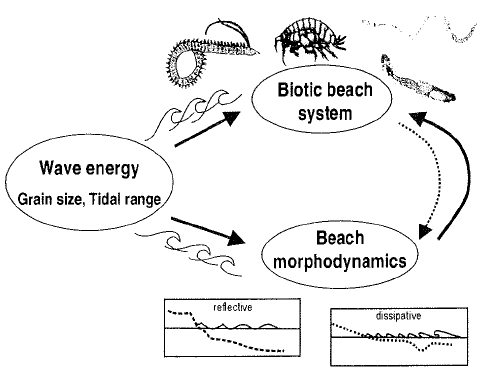Biogeomorphology
Wave energy associated with sediment particle size and tidal range has been emphasized as a major structuring force for beach morphology, and for the infaunal communities of these habitats (e.g. Brown & McLachlan 1990; Menn 2002). Thus, shore morphodynamics may considerably influence the biotic beach system which, in turn, can influence the physical nature of the beach (Menn 2002). Benthic (sea-bed) organisms may be classed as ‘ecosystem engineers’ or ‘bio-engineers’ in that their activity has a profound effect on their environment, resulting in a significant alteration of the sediment properties (Mazik et al. 2008).

Many studies have indicated that biological communities can alter the geotechnical properties of marine sediments, and can therefore impact on the geomorphology of the resulting bedforms. Several implications following this relationship are described (Murray et al. 2002):
- The importance of community ecology in sedimentological and geomorphological processes. For example, if within a community, one species is replaced by another species and these species differ in their geomorphological impact, the large-scale outcome will be radically different. Some species known to stabilise sediment are the mud-burrowing crustacean Corophium volutator, the burrowing polychaete worm Nereis diversicolor and the polychaete worm Lanice conchilega producing organic cement in tubes;
- The energetics of sedimentary and geomorphological processes. Geomorphological processes are dependent on the balance between driving forces and resisting forces acting on sediment. By incorporating the biomechanical activity of fauna into such processes, it naturally follows that the chemical energy stored in the tissues of organisms becomes available to do sedimentological or geomorphological work.
Some benthic species, such as Lanice conchilega, Echinocardium cordatum and Tellina fabula, may influence the sediment properties (i.e. they are considered to be bio-engineers). Each species has different effects on the sediment through different mechanisms (Borsje, 2012). The tube building worm L. conchilega protrudes several centimeters from the sediment in the water column, and thereby influences the near-bottom flow. For dense tube assemblages the near-bottom flow reduces, fine sediment will deposit and consequently lower ripples will form. Due to the digging and feeding activities of the bivalve T. fabula up to 10 cm deep in the sediment, the properties of the surficial sediment are modified and the sediment is more prone to erosion. The sea urchin E. cordatum lives in the top 20 centimeters of the bed and mixes sediment in vertical direction resulting in relatively coarser sediment in the top layer of the bed.
It has been concluded that bio-engineers may influence the morphodynamics of a nourishment significantly. Biogemorhological research has offered a parameterization in which biological activity is expressed in physical parameters. This gives us a first insight in the potential impacts of benthos on the stability of a nourishment as well as the feedback from the nourishment to the recovery of benthos.
